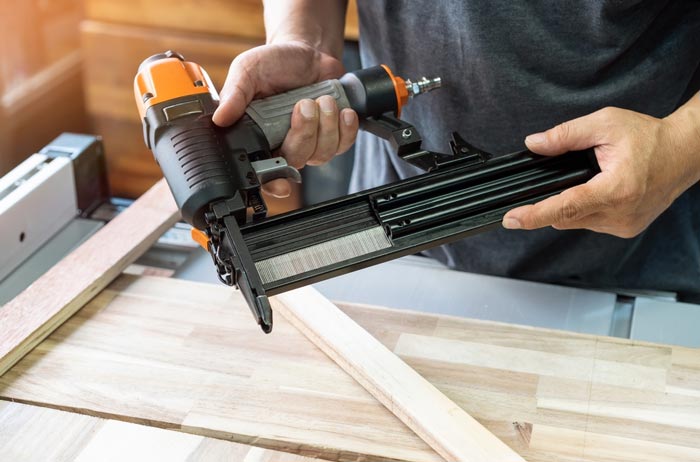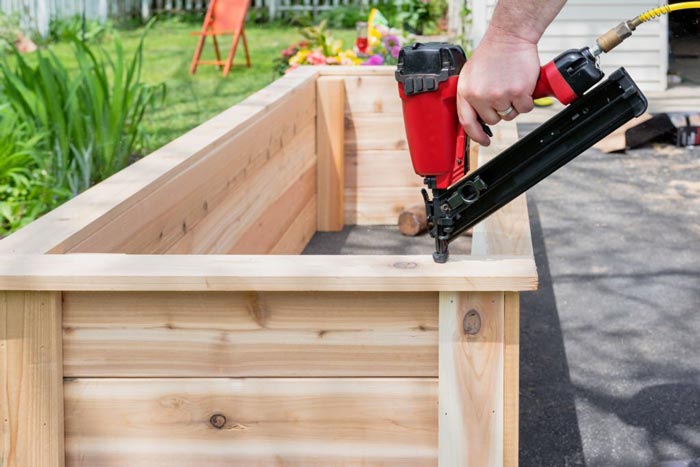There are many types of nailers to choose from. Most of them are very similar on the outside. However, each type is designed to perform different functions. Many people believe that all nailers do the same, but they’re wrong.
That happens with brad nailers and finish nailers. Many people often confuse them, but in essence they’re totally different tools.
Today we’ll help you understand the main difference between brad nailers vs finish nailers, so you can correctly choose the most convenient tool for you.
Brad Nailers vs Finish Nailers: The Major Takeaways
What is a Brad Nailer?

A brad nailer is a tool designed to fire brads using air pressure or electric power. They’re commonly used for delicate and precise duties, like installing wooden trims, moldures, baseboards, floorboards, panels and more. The have a smaller size than finish nailers and exert less force on brads.
Brads are usually thinner and smaller than normal nails. They’re made with 18 gauge steel wire and their length may vary between 0.625-2 inches. Unlike regular nails, brands have no heads, so they don’t leave big holes on the surface. So, they’re used primarily for aesthetic purposes.
Brad Nailer: Pros & Cons
Pros
- More portable and lightweight than finish nailers
- Ideal for working in tight spaces
- Ideal for trim, moldures and furniture
- They can be used in fragile wood pieces
- They can be used near edges and corners
- Powered by air pressure or electricity
- They don’t leave ugly holes in the wood
- Can be used to temporarily hold two pieces of wood together
- Cheaper than finish nailers
- Available in straight and angled design
Cons
- Brads tend to bend very easily
- Brads can’t withstand high loads
- Limited penetration
- Not recommended for heavy duties
- Low performance on too hard wood
- You need an air pump to use a pneumatic brad nailer
What is a Finish Nailer?

A finish nailer is designed to fire 15 or 16 gauge nails. They require more electric power and air pressure than brad nailers to apply more force. They’re recommended to work on hardwood, MDF and plywood. Finish nailers are more appropriate for heavy duties, like installing hanging cabinets or joining two big pieces of hardwood.
Nails are thicker and longer than brads. Their length may vary between 1-2.5 inches, allowing a greater penetration. They have big heads with sizes between 1.63-1.83 mm. This way, you can also nail them using a hammer. However, nails leave big holes on the wood surface, so they aren’t the most recommended for aesthetic purposes.
Finish Nailer: Pros & Cons
Pros
- Ideal for heavy duties
- They can be used on hardwood, plywood and MDF
- Powered by air pressure or electricity
- Nails can withstand high loads
- Nails have higher penetration than brads
- Available in straight and angled design
Cons
- Bigger and heavier than brad nailers
- Can’t be use on tight spaces
- More expensive than brad nailers
- They can break the wood piece when used near edges and corners
- You need an air pump to use a pneumatic finish nailer
- Nails leave big holes in the wood
Differences Between Brad Nailers & Finish Nailers
1. Hole diameter
The hole diameter directly depends on the head size. 15-16 Gauge nails can leave holes of 1.63-1.83 mm on the surface. On the other hand, 18-gauge brads are much more discrete, leaving 1.22 mm holes.
The hole diameter that finish nailers leave on the wood can also increase considerably with the angle. However, it remains the same when using an angled finish nailer.
2. Power source
Both brad nailers and finish nailers can work with electric power and air pressure. Pneumatic devices are lighter and cheaper. However, they’re less powerful and less portable than electric devices. In addition, to use them you’ll need to have an air compressor. To be able to carry your tool with you, the air compressor must be lightweight and have wheels for easy movement.
On the other hand, electric devices are more versatile, portable and powerful. You can take them with you everywhere and work on tight spaces. Cordless nailers are by far the best because they don’t depend on a nearby outlet to work.
3. Different uses
Finish nailers are usually used on hardwood, where higher penetration is required. With these tools you can install hanging cabinets, building furniture or joining two big pieces of wood. However, they’re less powerful than the framing nailer used in heavier labors, like framing walls, installing panels or constructing big structures.
On the other hand, brad nailers are better for more delicate duties, like installing trims and moldures and temporarily holding wood pieces in place.
4. Nails, brads and pins
Basically, what differentiates a nailer from another is the type of fastener it uses. Usually, fasteners are designated by their gauge. The higher the gauge, the finer the fastener. Finish nailers use 15-16 gauge nails. On the other hand, brad nailers use 18-gauge brads, which are finer than common nails.
For much more precise tasks, you can use a pin nailer, which uses 23-gauge pins.
5. Penetration
Best finish nailers and brad nailers come with an advanced depth adjustment system. This feature is very convenient because it allows regulating the force applied to the fastener. This way, the nail fully penetrates on the first try without damaging the wood piece.
Controlling penetration is very important when using finish nailers, because nails tend to be more difficult to remove than brads.
6. Loading method
Brad nailers and finish nailers can use magazines or canisters to store fastener loads. In the first case, you must place a strip of nails or brads inside the magazine to reload. This method is very practical; however, nails tend to run out too quickly, forcing you to reload frequently.
On the other hand, canisters provide a higher storage capacity, requiring less reloads.
7. Belt hook adjustment
This feature is available for brad and finish nailers. It allows hanging your tool on your belt. That way you can carry your nailer everywhere without using your hands. This is so convenient when you’re using different tools at the same time.
8. Angle adjustment
Models with this feature allow varying the angle of the nailer’s nose to adjust the penetration direction of the nails. That way, the nail gets deeper regardless of the surface inclination.
9. Corded vs cordless
Brad and finish nailers can be corded or cordless. Corded models allow for a higher power transmission and deeper penetration. However, corded models are less portable and working with them can be frustrating sometimes.
On the other hand, cordless models are less powerful, but you can use them anywhere. Unfortunately, the battery discharges too fast and you have to stop frequently to change or reload the battery.
10. Warranty duration
Only the best models from well-known brands have long lasting warranties. Before buying, make sure the product comes with service warranty and money back warranty. That way, you can recover your money if you aren’t satisfied. You also won’t have to spend extra money on future repairs.
Usually, the duration of warranties in these power tools may vary between 3-5 years.
Brad Nailers vs Finish Nailers: Which One Is Better?
To answer that question, you must first know the purpose you’re using this tool for and the money you’re willing to pay for it. For heavy duties, finish nailers are better. However, they’re more expensive.
On the other hand, if you need a nailer for more delicate and precise duties, it’s better to buy a brad nailer. Best of all, you won’t have to spend too much money to have one.
In conclusion, both models are excellent but you choose which one is better depending on your requirements.
Conclusion
As you can see, the differences between brad nailers vs finish nailers are many. Each nailer type has its own advantages and disadvantages. But, you’re the one who can determine which model is more convenient to use. To do this, you must know very well what you need from your tool.
After reading all this information, you’re certainly better prepared to make the best decision.
FAQ
Q. Can a finish nailer use brad nails?
A. No. Finish nailers are designed to work with 15-16 gauge fasteners. Brads are 18-gauge, so they aren’t compatible with finish nailers.
Q. What is an 18-gauge brad nailer used for?
A. 18-Gauge brad nailers are used for precise and delicate duties, like installing trims and moldures and temporarily holding wood pieces in place.
Q. Can you use a brad nailer for baseboards?
A. Yes. Brad nailers are perfect for baseboards because they don’t leave big holes on the surface. In these cases it’s convenient to use long brads for a better penetration.
Q. What kind of nail gun do you use for baseboards?
A. In these cases you can use both brad nailers and finish nailers. But, if you choose finish nailers, you’ll have to use wood filler to fill the holes.
Q. What kind of nailer do I need for trim?
A. Brad nailers are by far the best tools to install wooden trims. Brads are thinner and less prone to break fragile wood pieces.








